Résultats de recherche de titre
Articles 1 à 7 sur 7

This volume offers a new English translation, introduction, and detailed commentary on Sefer Meyasher 'Aqov, (The Rectifying of the Curved), a…
14th-century Hebrew treatise on the foundation of geometry. The book is a mixture of two genres: philosophical discussion and formal, Euclidean-type geometrical writing. A central issue is the use of motion and superposition in geometry, which is analyzed in depth through dialog with earlier Arab mathematicians. The author, Alfonso, was identified by Gita Gluskina (the editor of the 1983 Russian edition) as Alfonso of Valladolid, the converted Jew Abner of Burgos. Alfonso lived in Castile, rather far from the leading cultural centers of his time, but nonetheless at the crossroad of three cultures. He was raised in the Jewish tradition and like many Sephardic Jewish intellectuals was versed in Greek-Arabic philosophy and science. He also had connections with some Christian nobles and towards the end of his life converted to Christianity. Driven by his ambition to solve the problem of the quadrature of the circle, as well as other open geometrical problems, Alfonso acquired surprisingly wide knowledge and became familiar with several episodes in Greek and Arabic geometry that historians usually consider not to have been known in the West in the fourteenth century. Sefer Meyasher 'Aqov reflects his wide and deep erudition in mathematics and philosophy, and provides new evidence on cultural transmission around the Mediterranean.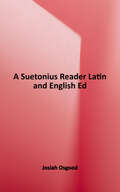
A Suetonius Reader: Selections From the Lives of the Caesars and the Life of Horace
Par Josiah Osgood. 2011
The popular appeal of Suetonius' Lives of the Caesars is obvious. Who would not thrill reading about the great Julius…
Caesar's delight in the Senates bestowal of the right to wear a laurel wreath on all occasions because it covered his baldness? Or that the Divine Augustus had rotten teeth and wore special platform shoes to make himself look taller? Suetonius, however, has not always been as enthusiastically received among historians, who sometimes overlook that he intended his work as biography, not history, or that he patently aimed for prose that was not literary, but instead unadorned, clear, and concise. Such qualities of prose, however, happily make his Latin enjoyable both to teach and to read. And while Suetonius' details of the weird worlds of extraordinary men are endlessly entertaining, they are not merely that. This business like biographer produced an extraordinarily influential work. His Caesars is a landmark in the history of biographical writing, and remains a key source for the history of Rome, its transition from Republic to Empire, and contemporary efforts to come to terms with individual destiny, through astrology, physiognomy, dream analysis, and more. Through to the present day Suetonius has profoundly shaped modern perceptions of Roman society.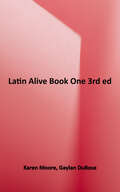
Latin Alive! (Latin Alive Series #Book One)
Par Karen Moore, Gaylan DuBose. 2008
Students will be delighted by what they learn in each new chapter of Latin Alive!, Book One, and they will…
learn to see that Latin is everywhere around them. As the first text in a three-year series, it is a rigorous and thorough introduction to this great language and is designed to engage upper school (middle and high school) student. Brimming with relevant facts and stories this text offers something for everyone. A Teacher’s Edition including answer keys, teacher’s helps and additional activities is available separately.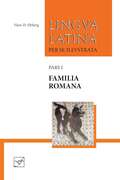
Familia Romana (Lingua Latina #Book One)
Par Hans H. Ørberg. 2011
Hans Ørberg's Lingua Latina per se Illustrata is the world's premiere series for learning Latin via the Natural Method. The…
Natural Method encourages students to learn Latin without resorting to translation, but instead by teaching them to think in the language: students first learn grammar and vocabulary inductively through extended contextual reading and an ingenious system of marginal notes. Lingua Latina per se Illustrata is also the most popular series for those teachers at both the secondary and collegiate levels who wish to develop Latin conversational skills in the classroom. Familia Romana (the main book of Pars I of the Lingua Latina per se illustrata series) contains thirty-five chapters and describes the life of a Roman family in the 2nd century A.D. It culminates in readings from classical poets and Donatus's Ars Grammatica, the standard Latin school text for a millennium. Each chapter is divided into two or three lessons (lectiones) of a few pages each followed by a grammar section (Grammatica Latina) and three exercises (Pensa). Hans Ørberg's impeccable Latin, humorous stories, and the Peer Lauritzen illustrations, reproduced in full color, make this work a classic. The book also includes a table of declensions, a Roman calendar, and a word index (index vocabulorum). The Lingua Latina series incorporates the following features: The most comprehensive treatment of Latin grammar available in an elementary textbook. A vocabulary of almost 1,800 words, reinforced by constant and creatively phrased repetition, vastly expands the potential for later sight reading. A complete line of ancillary volumes, exercises, and readers both in print and online.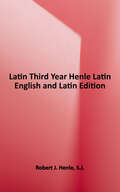
Third Year Latin (Henle Latin Ser.)
Par Robert J. Henle. 1959
Henle Third Year Latin is an introduction to the finest in Roman oratory emphasizes Cicero's cogency of arguments and develops…
an appreciation of his style. Separated into four parts, the third year of instruction will continue to strengthen the student's grasp of Latin, while also offering historical knowledge of the Roman Empire. Humanistic insight and linguistic training are the objectives of the Henle Latin Series from Loyola Press, an integrated four-year Latin course. Time-tested and teacher endorsed, this comprehensive program is designed to lead the student systematically through the fundamentals of the language itself and on to an appreciation of selected classic texts.
Familia Romana (Lingua Latina #1)
Par Hans H. Ørberg. 2011
Hans Ørberg's Lingua Latina per se Illustrata is the world's premiere series for learning Latin via the Natural Method. The Natural Method…
encourages students to learn Latin without resorting to translation, but instead by teaching them to think in the language: students first learn grammar and vocabulary inductively through extended contextual reading and an ingenious system of marginal notes. Lingua Latina per se Illustrata is also the most popular series for those teachers at both the secondary and collegiate levels who wish to develop Latin conversational skills in the classroom.Familia Romana (the main book of Pars I of the Lingua Latina per se illustrata series) contains thirty-five chapters and describes the life of a Roman family in the 2nd century A.D. It culminates in readings from classical poets and Donatus's Ars Grammatica, the standard Latin school text for a millennium. Each chapter is divided into two or three lessons (lectiones) of a few pages each followed by a grammar section (Grammatica Latina) and three exercises (Pensa). Hans Ørberg's impeccable Latin, humorous stories, and the Peer Lauritzen illustrations, reproduced in full color, make this work a classic. The book also includes a table of declensions, a Roman calendar, and a word index (index vocabulorum). The Lingua Latina series incorporates the following features:The most comprehensive treatment of Latin grammar available in an elementary textbook.A vocabulary of almost 1,800 words, reinforced by constant and creatively phrased repetition, vastly expands the potential for later sight reading.A complete line of ancillary volumes, exercises, and readers both in print and online.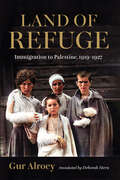
Land of Refuge: Immigration to Palestine, 1919–1927 (Perspectives on Israel Studies)
Par Gur Alroey. 2023
After the First World War, tens of thousands of Jews immigrated to Palestine. They went there not to found a…
Zionist state but primarily to seek refuge from the violence and persecution of the Russian Civil War and its aftermath. Fleeing to the United States was not an option due to heavily restrictive immigration laws enacted there in the early 1920s.In Land of Refuge , the experiences of this generation of Jewish immigrants come vividly to life through a wealth of previously unstudied archival sources. Historian Gur Alroey skillfully weaves together the riveting and remarkable stories of survivors of pogroms and riots in Ukraine and Uramia, including widows, orphans, and survivors of rape and other unimaginable violence; migrants who risked harrowing journeys by boat, only to endure illness on the way, be detained or sent back, or have their luggage broken into or stolen; survivors of the famine in Russia during the Lenin and Stalin regimes; and marginalized Jews such as the mentally ill, thieves, prostitutes, and those with falsified entry visas. The stories of the people at the core of Land of Refuge form an important but little appreciated part of the history of the Jewish settlement in the Land of Israel.